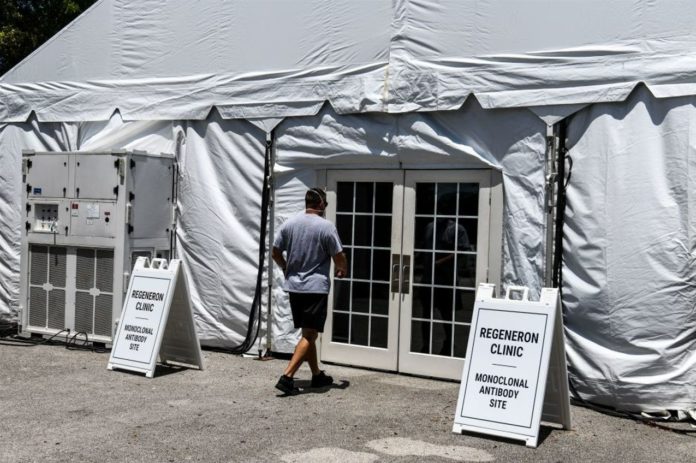Non-hospitalized people with early severe acute respiratory syndrome coronavirus 2 (SARS-CoV-2) infection and mild to moderate coronavirus illness are currently receiving monoclonal antibody (mAb) therapy.
Following the advent of mAbs for treatment, several SARS-CoV-2 mutations have appeared. There is, however, no indication that SARS-CoV-2 resistance mutations can result in altered viral replication dynamics or loss of treatment efficacy.
A study published on the preprint server medRxiv assesses the efficacy of a monoclonal antibody (mAb) to prevent disease progression in non-hospitalized people with symptomatic SARS-CoV-2 infection. The emergence of SARS-CoV-2 resistance mutations in the host following mAb treatment is described in this work, as well as their impact on viral load dynamics, symptom severity, and treatment efficacy.
The first approved monoclonal antibody treatment with Bamlanivimab
Bamlanivimab was the first monoclonal antibody permitted for emergency use by the US Food and Drug Administration (FDA). A clinical trial found that using bamlanivimab reduced the detection of SARS-CoV-2 in nasal swabs. It also decreased the likelihood of hospitalizations and death.
ACTIV-2/A5401 trial
ClinicalTrials.gov lists ACTIV-2/A5401 as a clinical trial. It is a test to assess the safety and efficacy of several antiretroviral drugs in preventing disease development in people who are not hospitalized and have symptomatic SARS-CoV-2 infection. One of the antiviral medicines investigated in this investigation is bamlanivimab.
Participants in this phase 2 randomized study were randomly assigned to receive an intravenous infusion of bamlanivimab or a placebo. Adults aged 18 and above who had a positive SARS-CoV-2 antigen test and a nucleic acid or PCR test within ten days of symptom start were eligible for the trial.
Bamlanivimab patients were given either 7000 mg mAb or 700 mg mAb. 48 of the 95 subjects who were randomly assigned to receive 7000 mg received treatment, whereas 46 received a placebo. This dose group was discontinued because another trial revealed that bamlanivimab 700 mg and 7000 mg have comparable efficacy. There were 223 people in the 700 mg study group, with 111 receiving treatment and 112 receiving a placebo. On study days 0, 3, 7, 14, and 28, the research team collected nasopharyngeal (NP) swab samples. Participants self-collected anterior nasal (AN) swabs every day until day 14, as well as on days 21 and 28 of the trial.
Side effects such as Fever, cough, shortness of breath or difficulty breathing, sore throat, body discomfort or muscular pain or pains, exhaustion, headache, chills, nasal obstruction or congestion, nasal discharge, nausea, vomiting, and diarrhoea were all observed at the same time.
The NP and AN swab samples were tested for viral load, and the viral spike protein was sequenced for identifying mutations.
The emergence of resistant mutations
In the bamlanivimab 700 mg treatment group, treatment-emergent resistance mutations were detected in 7% of participants. There were no treatment-emergent mutations among the 48 participants that received bamlanivimab 7000 mg. The emergence of SARS-CoV-2 resistance mutations was associated with a relatively consistent change in viral load kinetics. The participants detected with emerging mAb resistant virus had significantly higher pre-treatment NP and AN viral load.
The respiratory tract of the participants was intensively sampled, and it revealed the dynamic nature of SARS-CoV-2 evolution. There was a rapid and sustained viral rebound after the emergence of resistance mutations. This also correlated with symptom severity. It is important to note that there was no difference observed in the severity of symptoms between the treatment and placebo groups before the emergence of resistant mutations.
When the resistance mutations started emerging in the participants of the bamlanivimab 700mg treatment group, the AN viral load increased significantly, and the symptoms gained severity simultaneously.
The emerging mAb resistant virus also accumulated additional mutations found in current variants of concern and variants of interest. These mutations were apart from the bamlanivimab site of activity and may reflect an attempt to escape from host immunity.
Limitations and implications
Clinically, bamlanivimab is now used in combination with other agents. Even then, these results provide proof of principle for the role of drug resistance in the clinical efficacy of anti-SARS-CoV-2 therapies. A lack of treatment-emergent mutations was found in the 7000 mg group. This may be because of the limited sample size of this phase 2 study, especially in the bamlanivimab 7000 mg group.
For optimal therapeutic benefit, it is recommended that mAb treatment be initiated during the early stages of infection. The findings of this study suggest that there is a potential risk with mAb treatment due to the emergence of resistance mutations. The insights gained from this study could design anti-SARS-CoV-2 therapeutics while preventing the emergence of viral resistance.
Image Credit: Getty
